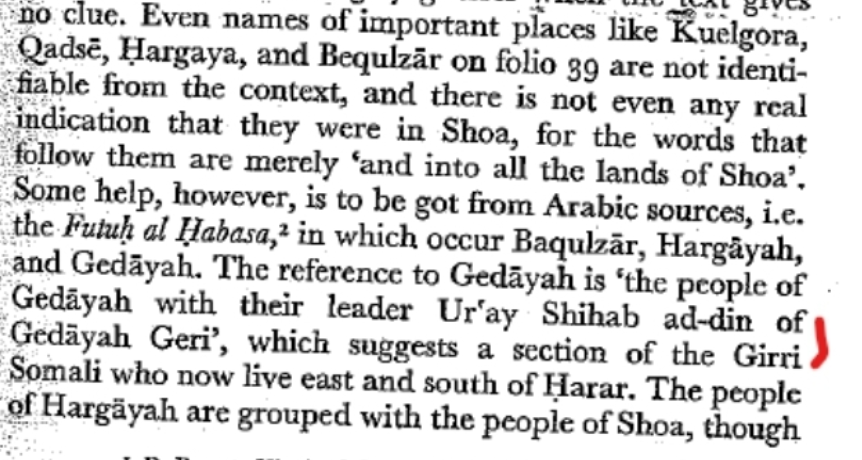Do we know if the Walashma dynasty survived after the 16th century or was the Harar emirate not really its successor?Harla was 1 single Somali darood clan that lived between hawash and at end the of upper shabelle. They didn't even live in Harar. There is zero proof they was a seperate ethnicity as well.

Around the same place futuh places them:

There was multiple Somali agro-pastoral clans living in the hawash river around showa that acted as a border Baqulzar, Gatur, Warjac , Hargayah etc even sections of Geri were sedentary agro-pastoralists with Gedayah Geri in the showa area.

It is Oromo oral mythology that blows them up an makes them something more than they are and ascribes to them stuff they are not even responsible for building. There is no Harla kingdom at all, they were just 1 clan among many.
A recent Oxford academic study says Somalis pretty much dominated Showa and conquered the Amhara province and expanded from the Somali inhabited areas.. They are basing this on cultural and material evidence that connects it to Somali inhabited areas away from the highlands, as it underwent a cultural change.

This is pretty much confirmed by Al-Maqrizi who says the Walashma founders expanded from Jabarta and a local medieval chronicle document who detail them to be by from Awdal.
Al-Maqrizi literally says they came from northern Somalia (Jabarta region connected to Zeila) and gradually moved further inland to occupy Awfat.

Local manuscript on the History of Walashma confirms and details the same thing about them conquering Shoa and incorporating it with Awdal (Zeila province).

You are using an out of date browser. It may not display this or other websites correctly.
You should upgrade or use an alternative browser.
You should upgrade or use an alternative browser.
I have seen many times people claiming Harar to be the fourth holiest city in Islam. Why is this the case?
- Thread starter Abdixakim
- Start date
Hotchick12
VIP
or somewhere in palestine, like hebron where abraham and sarah is buriedThis was my first though too. If there was ever s fourth holiest city in islam it would be somewhere like cairo or damascus. Not some small medieval town in the horn.
They exist to this day and they have their own dialect of somali like af maay and af tunni@Idilinaa @Step a side Now I'm curious about the Harla language/linguistics
IIRC, Richard Burton once stated he found a group in Somalia that spoke Af-Harlaad however I'm hoping for something more concrete and contemporary. Can you guys give me any Harla that had Somali namea or had Somali linguistic influences?
